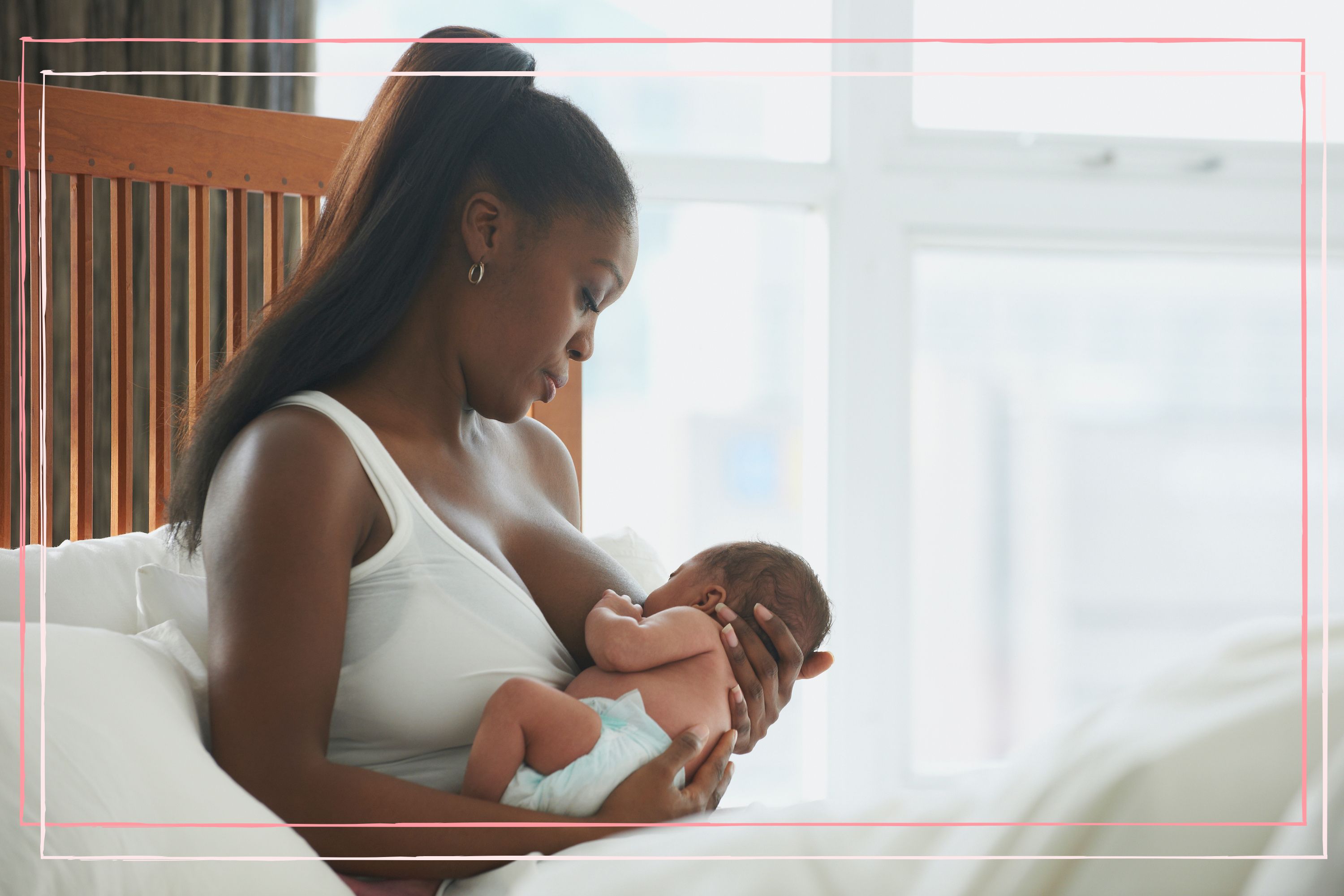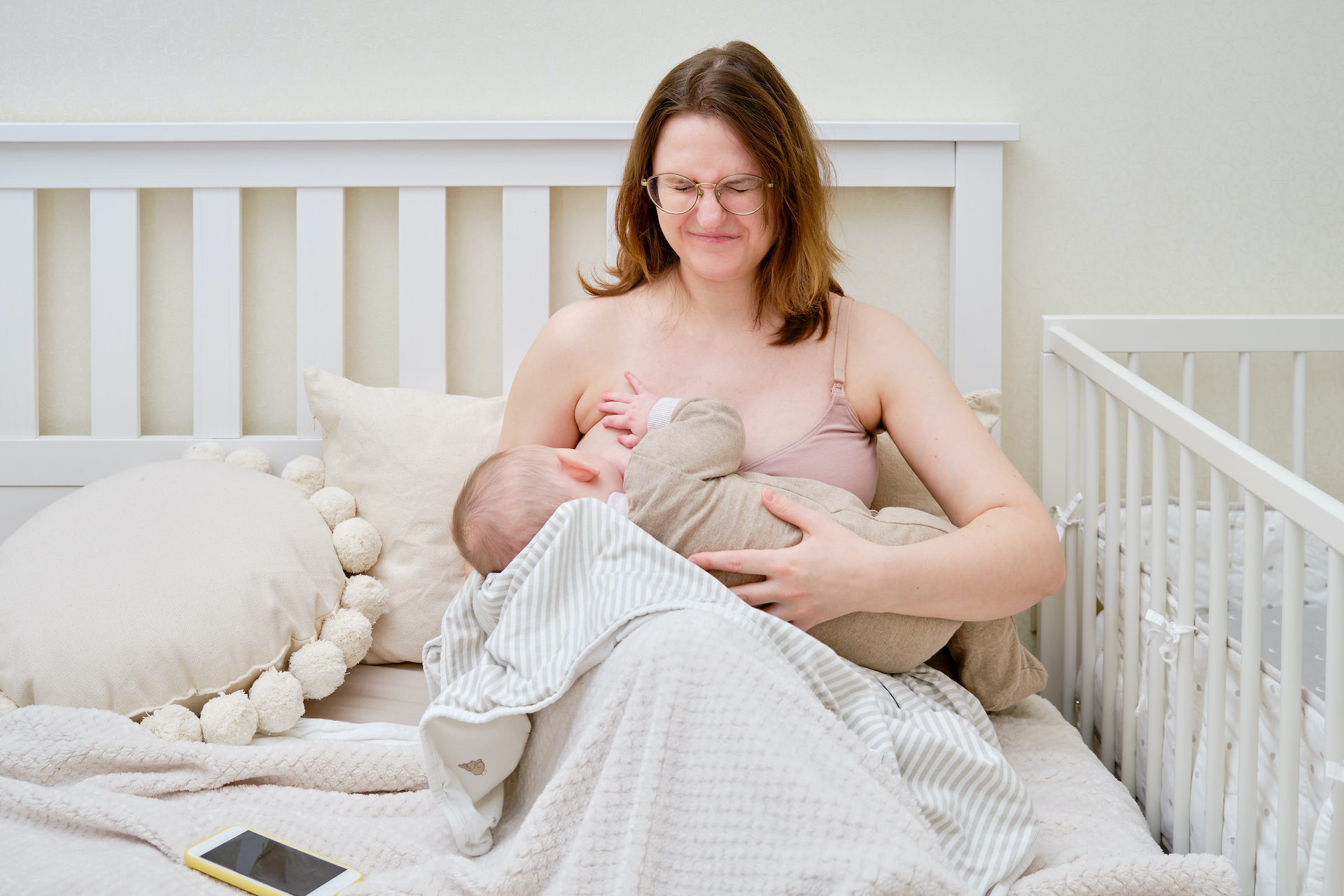9 things that happen to your breasts before, during and after breastfeeding
Breastfeeding doesn’t just come with practical considerations – there are various physical changes to contend with, too


Your body goes through a lot when breastfeeding - and not just during, but also before and after. We've spoken to the experts to discover what you can expect.
Milk leaks, nipple pain when feeding, mastitis and engorgement (when the breasts become very hard) and breastfeeding thrush are just some of the things commonly experienced by nursing mothers. There can also be changes to the size and shape of not just your breasts, but also your nipples.
Unsurprisingly, these changes happen because there’s a lot going on physiologically. “The breast tissue actually has a life cycle, and pregnancy and lactation complete the breast's life cycle to maturity,” says Dr Emily Spaeth, a lactation consultant and physical therapist. “Hormonal shifts, specifically elevated levels of progesterone and oestrogen, prepare the breasts for lactation throughout pregnancy."
However, as with most things about being a parent, there’s no ‘one size fits all’ pattern when it comes to breast changes when breastfeeding, and everyone’s experience will be different. “There’s a big range of normal,” confirms Emma Pickett, lactation consultant and presenter of the Makes Milk podcast.
Below we’ve outlined some of the changes you might see in your breasts when breastfeeding. Seek medical advice if you experience any changes that give you cause for concern, including bleeding from the nipples, a change in texture of your breast tissue that looks a little like thick orange peel, redness, swelling, heat, pain, or a fever.
9 things that happen to your breasts before, during and after breastfeeding
1. Tingling
A tingling sensation in the breast during feeding (sometimes likened to pins and needles) is common, and is felt during let down – the milk ejection reflex in breastfeeding women triggered by stimulation of your nipple and areola.
When a baby latches onto your breast and begins to suckle, nerve signals are sent to the brain stimulating the release of oxytocin (also known as the 'love hormone'). This causes the muscles in the breast’s milk-producing cells to contract, squeezing the milk into the milk ducts and out through your nipple.
Parenting advice, hot topics, best buys and family finance tips delivered straight to your inbox.
Whilst common, the experience will feel different for everyone. “Some people don’t feel anything when their milk is letting down; others might feel a little bit of a tingly sensation,” says Emma. “But for some people, the tingling sensation can be quite sore. They might even describe it as feeling like a little electrical shock.
“If you are somebody who experiences a painful letdown reflex, it’s not likely to stay that way for very long – usually it’s only the first few days or weeks that it’s particularly bad. Once your supply regulates, it often starts to get a bit easier.”
Some people might also experience a tingling sensation towards the end of a feed, too - a feeling Emma describes as “almost as if the milk is migrating back to the milk storage area.” If you experience ongoing pain when feeding, seek help from a lactation expert or health professional.
2. ‘Clogged’ milk ducts
What was once universally referred to as ‘clogged’ or ‘blocked’ milk ducts is now often called ‘milk stasis’ instead – that is, when milk is not fully drained from the breast and remains there longer than it should.
“‘Clogged milk ducts’ is a misleading term, because it makes people think that they have a physical blockage in the little ‘tube’ that we call a milk duct,” says Emma. “But actually, most blocked ducts aren’t that - it’s just a bit more milk being left behind in the milk storage areas [the alveoli] than is ideal. That milk then gets leaked out into tissue where it isn’t normally kept, and the body sends its immune response because it senses a foreign body.” This results in a firm area on the breast.
Whilst women were previously encouraged to perform vigorous massage in order to clear the so-called ‘blockage’, the advice on treating milk stasis has changed in recent years.
“The latest research shows we need to help the body to move the milk,” Emma says. This mainly entails getting the baby to feed effectively with good positioning, although very gentle massage – “no stronger than stroking a cat” – may help, along with a cool compress for comfort.
Once you’ve moved the milk effectively, you should find that that firm area of the breast should soften. However, if the milk is not drained, it can in rare cases lead to mastitis – a more serious condition.
The symptoms of mastitis can include a firmness in the breast that feels tender or sore, skin redness (in pale-skinned people) and a fever. If you suspect you might have mastitis, it’s important to seek medical advice straight away.
3. Nipple pain when breastfeeding
Nipple pain during feeds is a common experience, with 90% of women experiencing it during the first week. “When most people talk about breastfeeding challenges, nipple pain is often the first thing on the list,” confirms Emma.
“The most discomfort is usually felt during the first 20 seconds of the feed, when the baby’s mouth creates a vacuum that stretches the nipple to about two-and-a-half times its natural length.”
However, she stresses that just because it’s common, it should not be dismissed as normal or something that nursing mothers need to put up with. In the majority of cases, the pain is caused by poor positioning and attachment – both of which can usually be improved with the help of your midwife, health visitor or a lactation consultant.
Whilst common in the early stages, nipple pain during feeds can also develop later in your breastfeeding journey as your child grows. “You may need to seek breastfeeding positioning and attachment support as they get bigger and heavier,” Emma advises.

Nipple pain is common when breastfeeding, but not something that needs to be tolerated.
4. Nipple pain when not breastfeeding
Whilst nipple pain when breastfeeding is common, pain experienced outside of feeds is not normal. This could indicate nipple damage, an infection or mastitis, and help should be sought.
Sore nipples after you breastfeed could also be due to vasospasm, a condition caused by the blood vessels constricting in response to temperature change. "This usually happens right after feeding,” says Emily. “Your nipples might turn white or feel cold.” Keeping your nipples warm can help, she advises – for example, heating your bathroom before undressing for a shower, wearing extra layers and using nipple warmers.
5. Milk leaks
It can be frustrating when your breasts start leaking milk unexpectedly (especially if you’re wearing a freshly laundered top), but it’s reassuring to know that this happens to most nursing parents. “Milk leaking is pretty much universal when breastfeeding – it's rare to not experience it,” says Emma.
However, the frequency and volume of milk leaking can differ largely from person to person. Emma stresses that this is not necessarily linked to the amount of milk your body is producing – so there’s no need to worry if you only leak a little, or leaking suddenly stops.
She explains: “There are tiny sphincter muscles around the ends of milk ducts. If you've got a particularly strong set of sphincter muscles, you might stop leaking sooner than someone who doesn’t."
She adds: “We all have different numbers of milk ducts, so if someone’s got a lot of milk ducts they may find that they leak more or in greater volumes than someone who’s only got two or three duct openings. If someone stops leaking, we don’t want them to tip into panic mode and think that means they’re not making milk; it could just be that their body’s naturally adjusted and those little muscles have got a bit cleverer at holding the milk in.”
Leaking can sometimes happen in pregnancy, too. However, Emma warns against trying to collect and store that milk – a practice known as colostrum harvesting – until the 36-week mark, as per NHS guidelines, and only if deemed safe for you to do so by a health professional.
6. Engorgement
Engorgement happens when your breasts get very full, causing them to become hard, tight and possibly painful. “Most people will also notice that their nipples might be a little bit flatter, which can make it harder for the baby to latch on,” advises Emma.
Engorgement is very common during the first week or so after birth, as the body establishes lactation and replaces colostrum with full breast milk. This process draws lots of blood and lymph fluid to the breast, so it’s not just milk that causes engorgement at this stage. It should be reduced once effective and frequent feeding is established.
Engorgement can also develop later in your breastfeeding journey, and could be a cause for concern. “This can be a sign that your body is reacting to milk that should have been drained,” Emma says – for example, if you skip a feed and don’t pump, or when baby’s positioning is not quite right.
Engorgement may also be your body's normal response to a change in your baby's feeding patterns. For example, you might feel engorged when your baby starts to sleep for longer intervals and therefore goes longer without feeding. “Engorgement sends signals to your body to reduce production at times when milk isn't needed as much, but it should only last a short period and feel easier after a feed,” Emma shares.
In both cases, she advises: “If engorgement resolves easily then it’s nothing to worry about. But if it’s sticking around and causing a lot of discomfort, get some breastfeeding support and check that there’s no underlying problem.

A lactation consultant can advise on hold and positioning to help manage any discomfort.
7. Changes in breast shape
The notion that breastfeeding makes your breasts saggy is a myth, Emma tells us. “Research has clearly demonstrated that pregnancy is what affects the sagginess of the breast – along with weight changes and smoking,” she says.
That said, some people find that their breasts feel a bit empty and hollow after they stop breastfeeding – especially if they experienced engorgement, as the contrast may be more stark.
However, don’t assume that the way your breasts look immediately after you finish breastfeeding is the way they will look forever. “Things change once a few menstrual cycles have gone by and you’ve had a hormonal surge during each of those cycles,” Emma says.
Meanwhile, Emily encourages her clients to try strengthening the pectoral muscles (a press-up challenge could be a good option when you feel ready), breast massage, and getting to know the changed body they inhabit. “Ask yourself, who is she? And be kind and curious as you are getting to know the answer to that question."
8. Changes in nipple shape and colour
The appearance of your nipples might also be changed after breastfeeding, and these changes can be more permanent.
“A lot of people who maybe had flat or slightly inverted nipples pre-baby may find that they never have that again after they’ve breastfed – so don’t be disconcerted if your nipple shape does change,” Emma says.
Some women may also experience a darkening or lightening of the skin around the nipples (the areolas). Emily tells us: "Your baby's vision isn't great when they're born, but they can see contrast, so your body changes so it's easier for your baby to find the source of their food.
“Sometimes, these changes are permanent, but after the hormones of breastfeeding leave your body, it's common for your areolas and nipples to shrink and become less pigmented."
9. Blebs
Blebs are little blisters that form at the end of milk ducts. They trap milk, giving the appearance of tiny whiteheads on your nipple, although they can turn more yellow over time.
“Usually they’re caused by the nipple rubbing where they shouldn’t,” says Emma – for example, the back of baby’s tongue or the roof of their mouth.
Blebs will usually go away on their own, and shouldn’t be popped or removed due to a risk of infection. “If the breast is soft between feeds and feels comfortable, usually we suggest leaving the bleb alone – but maybe get some support around positioning and attachment, in case that is the underlying cause,” Emma advises.
If, however, you experience any pain or discomfort with blebs or there are obvious signs of a blockage, then seek medical advice.
The information on GoodTo.com does not constitute medical or other health advice or diagnosis and should not be used as such. Although GoodtoKnow consults a range of medical experts to create and fact-check content, this information is for general purposes only and does not take the place of medical advice. Always seek the guidance of a qualified health professional or seek urgent medical attention if needed.

Emma Pickett IBCLC is a certified lactation consultant, author and podcaster who has provided breastfeeding support to hundreds of women. She qualified with the International Board of Lactation Consultant Examiners in 2011 and received the Lactation Consultants of Great Britain award for outstanding contribution to breastfeeding in 2022. In addition to working with private clients, Emma volunteers at local breastfeeding support groups, the national Breastfeeding Helpline and the Association of Breastfeeding Mothers helpline. She also presents the Makes Milk podcast and is the author of four books about breastfeeding, including You’ve Got It In You: A Positive Guide to Breastfeeding.

Stephanie is former Acting Editor and Content Director at GoodToKnow. She is also mum to son Woody (don't worry, they don't share a surname!), who was born in November 2021. As a journalist, Stephanie has over 17 years' of experience, and has worked as a digital editor and writer for brands including Stylist, Fit&Well, MSN and Woman&Home.